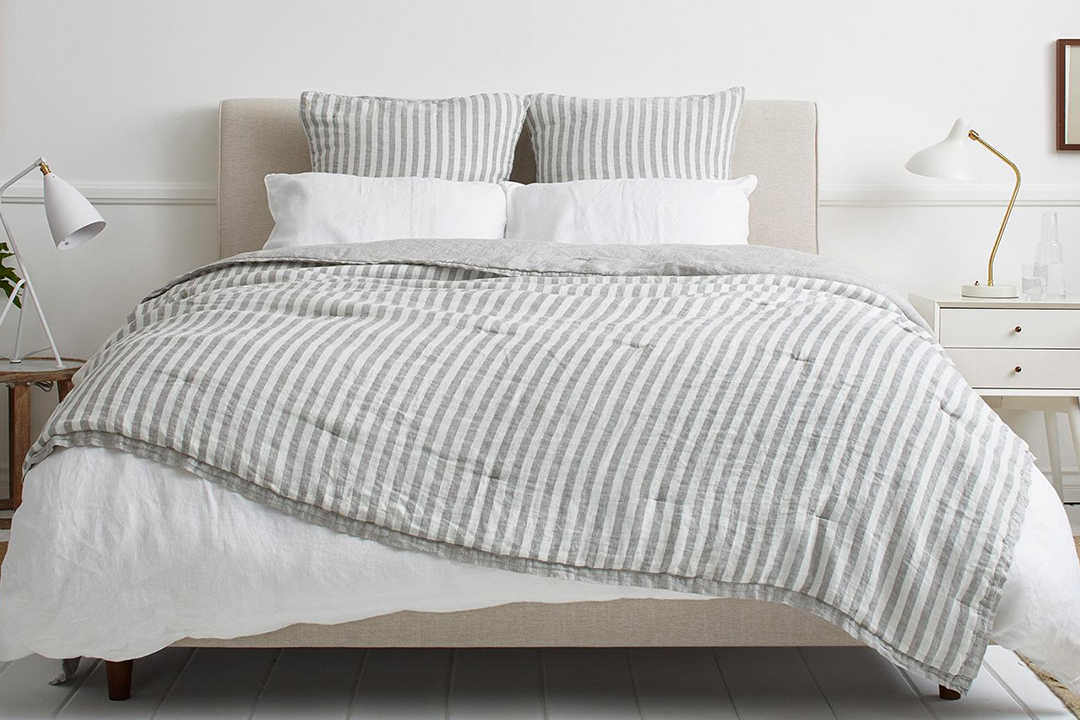- Expert advice/
- Relationship advice/
- Newlywed couples/
- How to Buy Homeowners Insurance
- Newlywed couples
How to Buy Homeowners Insurance
Whether you’re shopping for homeowners insurance for the first time or swapping out one policy for another, you want coverage that suits your needs and doesn’t break the bank.
Last updated February 5, 2024

Sponsored Content. We may earn compensation if you click the links or buttons below.
Whether you’re shopping for homeowners insurance for the first time or swapping out one policy for another, you want coverage that suits your needs and doesn’t break the bank.
Most mortgage companies require that you purchase homeowners insurance before closing on your house or condo. If you’re a first time home-buyer, choosing the right insurance company and policy may seem like an insurmountable task, which is where we come in.
Before you shop, make sure you’re familiar with what homeowners insurance is; figure out if you want to shop yourself or go through a broker; gather all the necessary information and paperwork; compare and select a policy; and lastly, choose a billing plan and sign.
Step 1: What type of homeowners insurance am I shopping for?
When you shop for your homeowners insurance policy, you should know what type of coverage you need and how much of each component you’ll need in order to make sure all your stuff is covered. The following components are in every standard homeowners insurance policy, commonly referred to as an HO3, and having an idea of how much coverage you need for each of these will make you a more prepared shopper.
Figure out your home’s replacement cost and personal property value
Every HO3 policy has hazard insurance coverage. Hazard insurance is the bulk of your policy and covers your home (dwelling coverage), your stuff (personal property coverage), and helps you relocate and pay for temporary living expenses if your home is uninhabitable (loss of use coverage).
Here’s how you determine coverage for each of these components:
- Dwelling coverage: In order to figure out your policy limit for dwelling coverage, you need to first figure out the build price of your home. This is the amount it would cost for a full rebuild and is otherwise known as your home’s replacement value. If you recently bought the home and don't have prior policies to reference it's rebuild price, be sure to consult contractors, builders, installers and roofing companies, and get replacement cost estimates for your flooring, cabinetry and appliances, roofing, and your house’s exterior. Besides the do-it-yourself approach, you could also opt to hire an independent appraiser to give your home a thorough inspection.
- Personal property coverage: To figure out a policy limit for your personal property, you may want to take an inventory of all of your personal belongings inside the home, value it, and calculate what it would cost to repair or replace your stuff if they’re damaged, destroyed, or stolen by a covered loss. Like dwelling coverage, you can also reference prior policies if your inventory hasn't changed all that much, but first time home insurance customers should consider taking a proper inventory.
- Loss-of-use coverage: Loss of use coverage is typically a fixed amount – 20% of your dwelling coverage, and policy limits for loss of use are set accordingly.
Figure out your liability and medical payments coverage
Deciding on your liability coverage is a little less time-consuming, as it’s suggested you just opt for the limit suggested to you by your insurer. But if you only have the house for you and yourself and don't have many investments, other property, or assets, you may be okay with a lower liability coverage limit.
Medical payments coverage should be enough to cover guests’ hospital bills if they’re injured in your home. Medical payments coverage is generally anywhere from $1,000 to $5,000.
Figure out if you need any additional coverage
If you live in an area susceptible to floods or earthquakes, you may be required to add flood and earthquake insurance. That’s because a standard homeowners insurance policy doesn’t cover perils like floods, earthquakes, and mold. Luckily, all three of those perils can be covered with add-ons, or floaters, to your policy.
You should also consider water backup coverage to protect against water damage as a result of bad plumbing or sewage backup; floaters for expensive items such as jewelry not covered under personal property coverage; and an increase in liability coverage using a personal umbrella policy if you own a pool or have assets worth more than the liability coverage limits in your policy.
Step 2: Figure out how you want to shop for homeowners insurance
After you’ve studied up and done your homework on homeowners insurance and have a general idea of your coverage needs, you’ll determine whether you want to shop on your own or go through an insurance broker.
Shopping on your own
If you choose this route, a good thing to keep in mind when evaluating insurers is how they handle the claims process. Some major insurance companies are far better at handling the claims process than others, and you should zero in on this when comparing them, as the single best indicator of home insurance customer satisfaction is the company’s damage estimates. Stay away from insurers who have a reputation for low-balling customers and producing small settlements when you file a claim.
Also try to not limit yourself; the best way to shop for insurance is to cast a wide net so you’re not missing out on any deals or discounts. Having multiple policies to choose from also gives you negotiating leverage if an insurer you’re close to signing with refuses to budge on say, allowing your dog to be covered on the liability portion of your policy; they’re more likely to provide coverage if you can point to a handful of other policies that have no issues with covering your very good pup.
Shopping through an insurance broker
If you’re not into the do-it-yourself approach, going through a broker is your other option. The advantages of going through a broker, to name a few, is that they’re licensed professionals who understand what to look for and what to avoid in a home insurance company and policy. You’re still responsible as the homeowner and policyholder to provide necessary paperwork and information, but the extent of that isn’t nearly as cumbersome if the broker is ironing out all the fine details for you.
If you have an existing policy that you need canceled or need your new policy added to your mortgage, look no further than Policygenius. Our licensed agents will provide you with the expertise, unbiased coverage recommendations and help get you signed up for a policy that's effective and affordable for you and your home.
Step 3: Information you’ll need when you shop
The more details you have about the home, like the interior specs, the more accurate your quote will be. If you’re simply swapping out policies, most of this information will be available on your old policy.
Here’s a rundown of the information you may need to provide to your agent or broker in order for them to produce accurate quote estimates when you apply.
Home information
- Address of your home: Your home does have an address, right?
- Insurance appraisal: To determine the full rebuild value of the home if it's damaged or destroyed. This can be done by referencing a recent home insurance policy, hiring an appraiser, or hiring roofing companies, contractors, and builders to assess value to individual parts of your home.
- Prior insurance inspection reports: Inspection notes from previous insurers can be helpful in determining a multitude of coverage considerations; if they noted that your plumbing is old and requires water backup coverage, your next insurer may take note of that and quote you on the additional coverage.
- Prior insurance: If you’re buying insurance for the same home you’ve lived in under previous policies, simply provide the broker or agent with your prior insurance policy so they can fetch information like: homes square footage, heating type, age of your roof, plumbing specs, electrical specs and distance from fire departments.
- Lender requirements: Let your broker know if your mortgage lender requires any additional levels of coverage, like flood insurance or water backup coverage.
You’ll also need to list who will be living in the insured home, whether you’ll be renting the home out or not and if you consider the home a primary or secondary residence. For example, if you’re renting it out or use the residence as a home office, your insurance broker may offer suggestions to maximize your home insurance tax deductions that are available for rental or home office properties.
Personal information
- Date of birth: This can help an agent or broker access your insurance history.
- Occupation: Depending on your occupation, you may be eligible for certain discounts or group rates.
- Social Security number: To access your credit history which better informs the rates you’ll be paying.
- Property history: If you haven’t lived at the home you’re seeking coverage for at least two years, you’ll be asked to provide addresses for previous residences.
- Liability questions: Carriers will want to know if you have any pets, trampolines, tree forts, or pools (and whether the pool is above-ground or in-ground, specifically).
Step 4: Compare quotes and select a policy
After you’ve given your agent all the required information about your home, it’s time to fetch you some quotes and select a home insurance policy. The best practice here is to make sure you and your agent analyze a variety of options so you’re able to do a proper comparison.
Don’t just look at the price
Cheap is good, there’s no denying that, but when selecting a homeowners insurance policy, cheap doesn’t tell the entire story. In fact, what you may find is the amount you’re quoted isn’t anywhere close to the amount you end up paying.
Say, for instance, the premium for the cheapest policy is a solid $15 less per month than the next affordable policy. Great deal, right? Well, if you do a little digging, you may find that the “cheap” policy is actually full of exclusions and low coverage limits that require additional coverage. Once you’ve accounted for all that to meet your coverage needs, your premiums may end up being far higher than they led you to believe.
Apart from the policy itself, you’ll also want to look into the insurance company’s background. Be sure they’re a financially stable company, read customer reviews and check their ratings with consumer insights companies like A.M. Best and JD Power and Associates, to name a few.
Questions to ask
Your broker will most likely give you their policy recommendation and provide you with all the information you need before settling on a policy. Once you have one picked out, you’ll want to ask them some questions about your policy.
What perils are covered?
In a standard homeowners insurance policy, also known as an HO3, it will list all the causes of loss or perils that your home and personal items aren’t covered against, but you’ll want to double check and make sure that perils not listed are actually covered and you may want to consider adding additional coverage to cover perils (like water damage, floods, and mold) not covered in a standard HO3.
Which of my things are covered?
You’ll also want to make sure certain property-types and structures that you own – pools, trampolines, tree-houses, air-conditioning units, and other appliances – are covered both in the liability and personal property coverage portions of your policy, or if there are specific conditions where they won’t be covered.
For example, you may only get liability coverage for injuries sustained on your trampoline (or, off your trampoline for that matter…) if you have protective netting around the exterior of the structure.
Do I have an actual cash value (ACV) or replacement cost value (RCV) policy?
These types of policies determine the amount of a covered loss the insurer will actually cover.
- Actual cash value policies only reimburse you for the replacement cost of whatever was damaged but minus the structure or properties’ depreciation in value over time.
- Replacement cost value is the repair or replacement cost of your house or property but the depreciation amount isn’t deducted from the payout.
If you have a newer home, you’ll probably be safer with an ACV than folks with an older home. But replacement value policies are seen as the most cost-effective option in the long run.
Does my homeowners insurance cover my partner or guest?
Home insurance policies typically cover blood-relatives or spouses but won’t cover unmarried partners or guests in your home. To get your partner covered, check with your insurer to see what their policy is for adding unrelated people to plans and if so, what the additional cost is.
Step 5: Finalize your policy details
You’ve compared quotes, gotten all your most pressing questions answered and selected a policy, now it’s time to choose a billing plan and policy deductible.
If you’re buying a home and need homeowners insurance to close on your house, there are a few details you need to finalize first:
- Premiums: It's common practice for lenders to require that premiums for the year be paid in full ahead of closing. Be sure to clarify with your agent if this is the case – they will be in contact with your lender about coverage and billing requirements for how your insurance will be paid moving forward.
- Deductible: You’ll also need to set your policy’s deductible, which is the amount you pay before your claim for damages is covered. From a cost standpoint, what you’re looking for is a low monthly or annual premium. So if you don’t plan on filing many claims, choose the higher deductible.
- Effective dates: Lastly, you set the policy’s effective dates, such as it’s closing date and whether or not you’d like the policy to be automatically renewed after the closing date.
Once your billing and policy dates are set and your lender approves the policy, sign on the dotted line and voila! You have yourself a homeowners insurance policy.
Step 6: Welcome the insurance inspector
Your home insurance carrier will typically perform an inspection of the property to make sure everything is in order and reported as quoted. If anything is off or you forgot to mention something in your application (maybe your roof is about 10 years older than you stated on your application, or on the flip side, maybe your home has certain safety and security features like burglar alarms and storm proof windows that you forgot to mention) your adjuster will take note of the errors and omissions and you’ll see it reflected – for better or worse – in your next bill.
You should use the inspector’s visit as an opportunity to pick their brain about various discount opportunities and get those rates lowered. Remember, they’ve looked at a number of houses just like yours, and may have some good ideas for that roof that’s currently causing your rates to skyrocket and replace it with something that will actually help you save (storm-proof shingles, anyone?).
This article originally appeared on Policygenius

Policygenius makes it easy to compare and buy insurance. Since 2014, they have helped over 4.5 million people shop for insurance, and protected customers with over $20 billion in coverage. The team is driven by one simple mission: “To get people the insurance coverage they need and make them feel good about it."
Get StartedUp next for you

How Spouses Can Shop For Life Insurance
Insurance
Save time and hassle by shopping for policies together to protect your family’s future.

How to Buy Renters Insurance
Insurance
You can get renters insurance entirely without speaking to anyone else: Some insurers automate the whole process through an app or website.

How To Buy Family Life Insurance
How-To
There are several ways to protect your whole family with life insurance, and we can walk you through your options.

12 Ways to Get The Most Out of Your Engagement Photos
Getting Engaged
It’s not uncommon for a wedding photographer to include an engagement photo session in their packages. Here's how to make the most of those photos.
Featured

How to Talk About Marriage When Dating
How To
Want to find out where your partner stands on marriage, but not sure how to broach the subject? Read on to find how and when to talk about marriage when dating.

10 Things You Should Do as a Newlywed
List
From financial planning and taxes to insurance and legal documents, follow this 10-step list to help you get your newlywed life up and running smoothly in no time.

21 Last-Minute Wedding Gift Ideas
Inspiration
If you've waited too long to select a gift for the couple, we've got you covered! Explore our 21 last-minute wedding gift ideas that will still impress.

8 Bedroom Items You'll Forget to Add to Your Wedding Registry
Inspiration
Don't miss out on these bedroom must-haves on your wedding registry. From a high-quality air purifier to luxe pillows that make all the difference, here are bedroom items you might forget to register for.
- Expert advice/
- Relationship advice/
- Newlywed couples/
- How to Buy Homeowners Insurance
Find even more wedding ideas, inspo, tips, and tricks
We’ve got wedding planning advice on everything from save the dates to wedding cakes.
